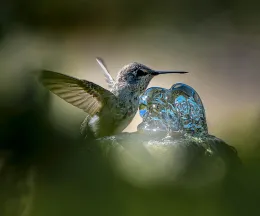
Welcome Pollinators! Supporting pollinators is easy in the foothills
by Kitty Stewart
UCCE Master Gardeners of El Dorado County
Supporting pollinators is easy and beautiful here in the foothills. Fragrant blossoms attract bees, butterflies, and hummingbirds in our gardens. The pollinators support the health of our flora, both the gardens that we plant, and the commercial crops grown in our area.
About pollinators
Bees are critical to pollination, especially for our vegetable and flower gardens. We generally think of honeybees, but our native bees are far more effective pollinators for native plants and some commercial flowers, and are generally not aggressive. California is home to over 1,600 species of native bees, many of them ground-dwelling. Bees require warmer temperatures to fly and to forage, so until the temperature is over 55 degrees, and reliably closer to 70 F, they will not be out and pollinating. They come out a bit later in the spring, waiting for the native flowers, oaks, fruit trees, lavender and rosemary to bloom.
Pollinators also include beneficial insects, birds, and bats. We think of hummingbirds when we think of pollinators, but other birds also aid in pollination, and in the spreading of seeds. Bats are particularly good at pollinating night-blooming flowers and may often be the only pollinator for these night-blooming plants. Bats are attracted to squash gourd and agave flowers. Moths and some ants may also be night pollinators. These nocturnal species may be repelled by light pollution, so make sure that the glare of your security lights doesn’t prevent them from seeing their night flowers.
Pollinators aid in plant reproduction, but we also need to attract predators of the pests that damage our crops. Predators include lady bugs, lace wings, and parasitoids like wasps and some flies.
Plan a pollinator garden
Plan your garden to create a space that invites pollinators to join you in your yard and help support the wellbeing of your own plants. Select varieties of plants that grow well in your area. Consider using primarily native plants. Plants that have not evolved in our region will not provide the same ecological benefit as native plants. Chose natural forms of plants. Double flowers often have less nectar, pollen, and seed. You might also choose to limit purely ornamental plants, making sure to have garden areas that produce the flowers that serve particular types of pollinators.
Try to allow for water and shelter for butterflies and birds and include herbs that will provide food for yourself– and for aromatherapy! Try to create a combination that creates ten square feet of blossoming plants, to make it worth the trip for the pollinators. You can do that just using pots, but planting bushes and trees will quickly expand the buffet for our pollinating visitors. Select plants that bloom at different times of year, to have blossoms throughout the seasons. More diverse environments are also more resilient to pests, diseases and climate change.
By planning out your garden, you can have an oasis not only for yourself, but for the pollinators that keep our environment healthy.
This article first appeared in the May 21, 2025 Mountain Democrat.
